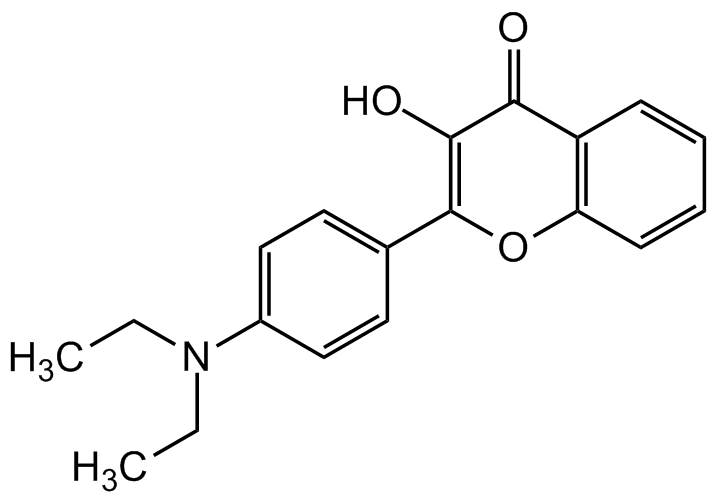
Chemical Structure
4-Diethylamino-3-hydroxyflavone
CDX-D0202
CAS Number146680-78-6
Product group Chemicals
Estimated Purity>90%
Molecular Weight309.36
Overview
- SupplierChemodex
- Product Name4-Diethylamino-3-hydroxyflavone
- Delivery Days Customer10
- CAS Number146680-78-6
- CertificationResearch Use Only
- Estimated Purity>90%
- Molecular FormulaC19H19NO3
- Molecular Weight309.36
- Scientific DescriptionChemical. CAS: 146680-78-6. Formula: C19H19NO3. MW: 309.36. Synthetic. Fluorescent dye that exhibits dual band fluorescence emission which is sensitive to environmental factors. One band originates from the normal excited state (N*) and the other is due to the excited state intramolecular proton transfer (ESPIT) reaction product tautomer (T*). An increase in solvent polarity and hydrogen bonding ability of the solvent leads to an increase in the population of the N* form relative to the T* form. The intensity ratio of the normal and tautomeric fluorescence bands are near 510nm and 570nm, with a main absorption band (370-420nm). There exists a latent third emission band peaked at 535nm, which is reliably recorded upon excitation at wavelengths of 470-500nm. The positions of the two bands, as well as their intensity ratios are sensitive to the local environment, making many of these compounds attractive ratiometric fluorescent sensors. Attaching such fluorophores covalently to peptides and proteins, peptide-membrane interactions and structural changes of proteins can be studied. Furthermore, this dye may have important future applications as fluorescent sensors for the detection of adenosine triphosphate (ATP), as their excitation spectra are sensitive to ATP and this effect is selective over other nucleotides. - Fluorescent dye that exhibits dual band fluorescence emission which is sensitive to environmental factors. One band originates from the normal excited state (N*) and the other is due to the excited state intramolecular proton transfer (ESPIT) reaction product tautomer (T*). An increase in solvent polarity and hydrogen bonding ability of the solvent leads to an increase in the population of the N* form relative to the T* form. The intensity ratio of the normal and tautomeric fluorescence bands are near 510nm and 570nm, with a main absorption band (370-420nm). There exists a latent third emission band peaked at 535nm, which is reliably recorded upon excitation at wavelengths of 470-500nm. The positions of the two bands, as well as their intensity ratios are sensitive to the local environment, making many of these compounds attractive ratiometric fluorescent sensors. Attaching such fluorophores covalently to peptides and proteins, peptide-membrane interactions and structural changes of proteins can be studied. Furthermore, this dye may have important future applications as fluorescent sensors for the detection of adenosine triphosphate (ATP), as their excitation spectra are sensitive to ATP and this effect is selective over other nucleotides.
- SMILESO=C1C2=C(C=CC=C2)OC(C3=CC=C(N(CC)CC)C=C3)=C1O
- Storage Instruction-20°C,2°C to 8°C
- UNSPSC41116134
